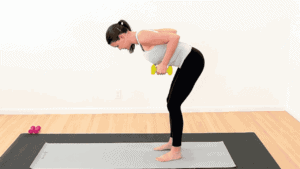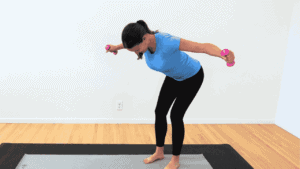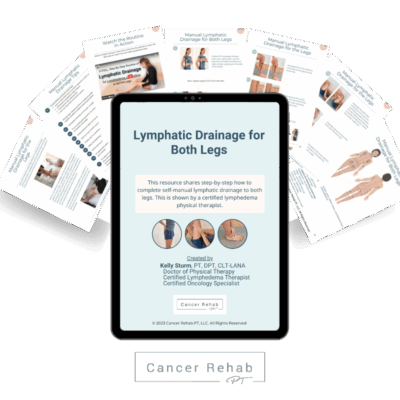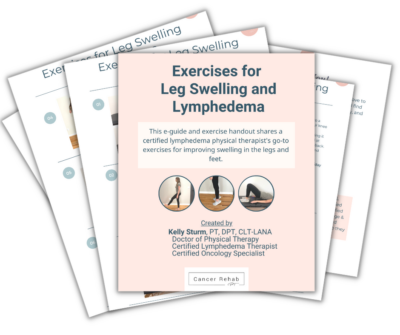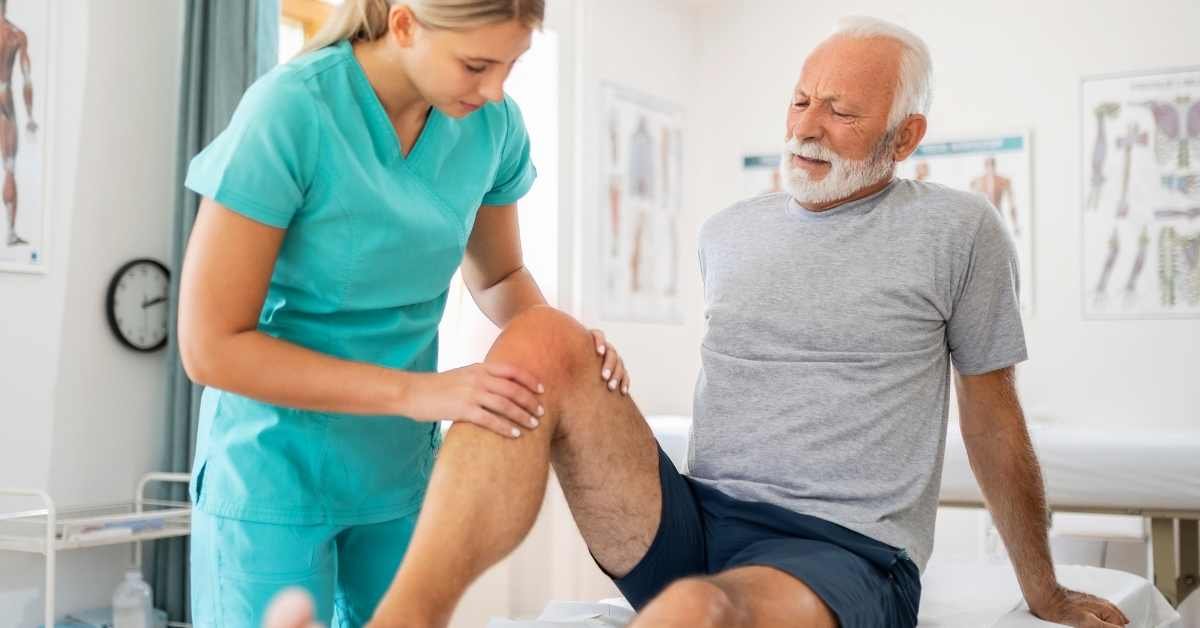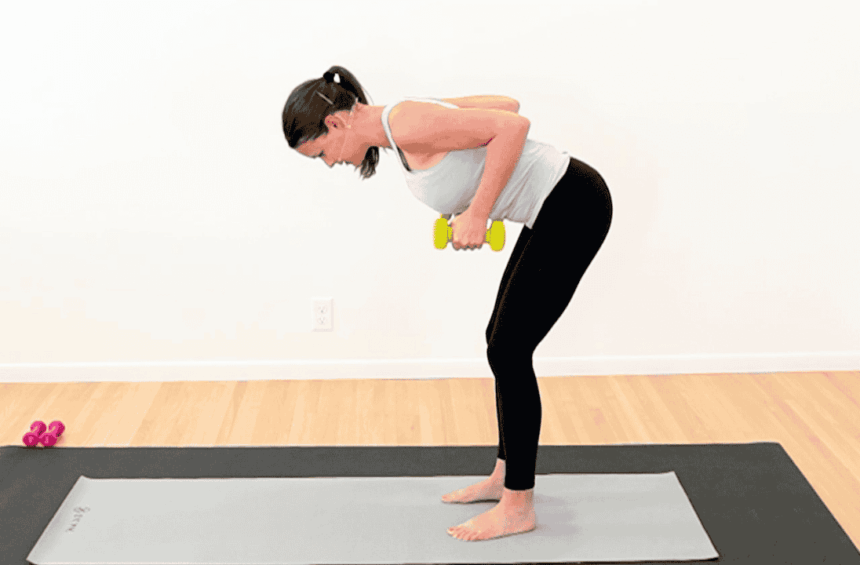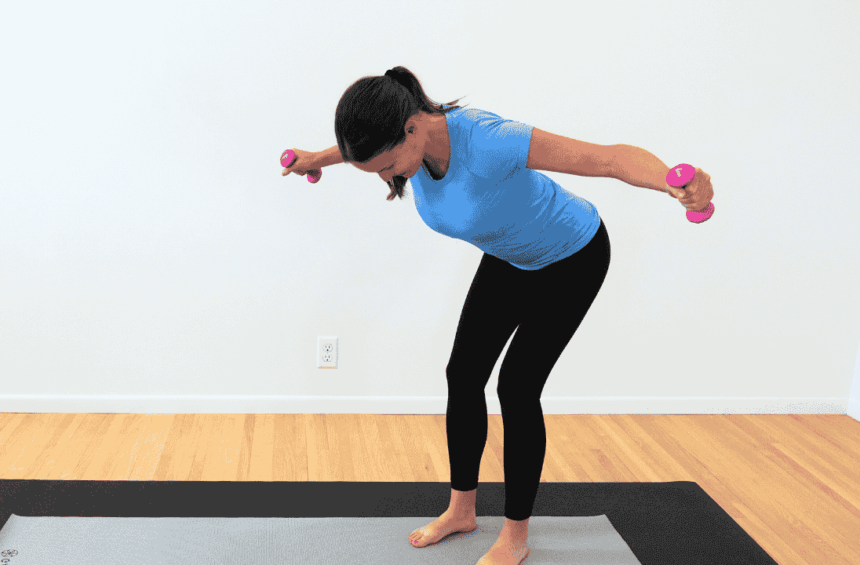Knee swelling can be frustrating and painful. This fluid buildup, also known as edema or knee effusion, is often a result of an injury, surgery, or chronic condition like lymphedema.
Knee pain and swelling are sometimes normal. For example, if you’re recovering from a knee replacement surgery, the swelling in the knee should gradually go down. But for some people, it can linger on for months or even years later.
So, how do we get rid of the swelling? I’m a Doctor of Physical Therapy and a Certified Lymphedema Therapist, and I’ll share 4 most effective exercises to reduce fluid in the knee – along with other treatments – in this article.
What Is Knee Swelling?
Your knee is probably swelling because there’s excess fluid that accumulated in your knee joint. This can happen for many reasons:
- Knee replacement surgery
- Other knee surgeries
- Injuries
- Arthritis
- Lymphedema
- Other medical conditions
Typically, swollen knees are temporary and the discomfort should reduce as your injury heals. But in some cases, knee swelling can be chronic. Rheumatoid arthritis and lymphedema are conditions that may cause chronic knee swelling.
Knee Swelling After Surgery
According to the American College of Rheumatology, approximately 790,0001 knee replacement surgeries happen in the US every year. This number is projected2 to grow to 3.5 million procedures per year by 2030 as our population ages.
Pain and swelling are the most common complaints after a knee replacement.
During surgery, the doctor cuts the skin, soft tissues, and bones. After knee surgery, your body needs time for the healing process, so it’s common to have more blood flow to the area for a little while.
This is called surgical swelling, and it should last for about 4-6 weeks.
You may notice swelling around the knee, above, below, or even into the lower leg and around the ankle area. It may get worse at the end of the day, especially if you’ve been active.
Signs That You Have Fluid Buildup in the Knee
How can you tell if you have fluid buildup in your knee? Look out for these signs:
- Visible swelling or puffiness around the knee
- Difficulty bending or straightening your knee fully
- A feeling of tightness or stiffness in the knee
- Warmth in the affected area
- Pain or discomfort, especially when moving or touching the knee
- A squishy or “water balloon” sensation when pressing on the knee
If you notice these symptoms, it’s a good idea to check in with your medical provider.
Doing exercises to reduce fluid in the knee can help you recover faster or, if your knee is chronically swollen, manage it better.
4 Exercises to Reduce Fluid in the Knee
Your muscles act as a natural pump for your circulatory and lymphatic systems. When you’re active, your muscles help push fluid up and out of the affected knee.
After surgery or injury, many people rest and recover (which is important, of course). But too much inactivity can cause more fluid to pool around the knee.
Doing gentle exercises like ankle pumps, knee bends, and leg raises can relieve knee swelling. Going on walks can help, too.
For more exercises for leg and knee swelling, learn more about my program Lower Body Lymphedema Rehab.
1. Ankle Pumps
Ankle pumps are a simple but effective exercise to get fluid moving out of your leg and knee.
How to do ankle pumps:
- Lie down or sit with your leg elevated on a pillow or wedge.
- Point your toes towards your nose, then push them away from you.
- Repeat this motion 20-30 times, a few times a day.
This exercise activates the calf muscles, which help pump fluid back toward your heart.
2. Knee Bends
Knee bends help improve circulation and reduce swelling by gently compressing and releasing the knee joint.
How to do knee bends:
- Lie on your back with your leg straight.
- Slowly bend your affected knee, sliding your heel up.
- Hold for a few seconds, then slowly straighten your leg.
- Repeat 10-15 times, 2-3 times a day.
If you feel discomfort or pain, stop the exercise (especially when recovering from a knee injury).
3. Leg Raises
Leg raises strengthen the muscles around your knee and help pump fluid out of the area.
How to do leg raises:
- Lie on your back with your unaffected leg bent and your foot flat on the floor.
- Keep your affected leg straight and slowly raise it to the height of your other knee.
- Hold for 5 seconds, then slowly lower your leg.
- Repeat 10-15 times, 2-3 times a day.
Your physical therapist may recommend other exercises, too.
4. Walking
Walking is a great low-impact exercise to reduce knee swelling.
Start with short distances and gradually go on longer walks as you feel comfortable. Wear supportive shoes with good cushioning and avoid surfaces that put extra stress on your knees.
Elevation and Icing
Elevating your leg and applying ice are two effective ways to reduce swelling. Elevation uses gravity to help drain excess fluid. In turn, icing narrows your blood vessels and reduces blood flow and swelling in the area.
Follow these steps:
- Lie down and prop your leg up on pillows so that your knee is above your heart.
- Apply an ice pack to your knee for 15-20 minutes.
- Repeat this process 3-4 times a day.
You should start seeing your swollen knee improve shortly after.
You might also be interested in:
Compression Therapy
So, what happens when the swelling doesn’t go down as expected?
As a Certified Lymphedema Therapist, I often see people with swelling in the knee that develops as a result of chronic conditions like lymphedema or venous insufficiency. Especially in combination with knee surgery or an injured knee, there can be severe swelling in these cases.
Compression therapy is a great way to manage persistent swelling.
Different types of compression garments can be used:
- Compression stockings: Available in knee-high or thigh-high options.
- Velcro wraps: These are adjustable and easy to use.
- Custom compression garments: For severe cases or unique anatomical needs.
With compression garments, it’s very important to buy the correct size that fits properly.
If you get a garment that’s too small or too tight, you’re at risk of getting a tourniquet. This is when the compression stocking digs into the skin too much and can actually make the swelling worse or cause some skin breakdown.
Complete Decongestive Therapy
If you have moderate or severe swelling, you might need to do Complete Decongestive Therapy (CDT).
CDT is an intensive treatment program that combines different techniques to reduce swelling and improve circulation. You typically work with a Certified Lymphedema Therapist, and there are two phases: an intensive treatment phase and a maintenance phase.
Complete Decongestive Therapy typically involves:
- Manual Lymphatic Drainage (MLD): A massage technique that helps the lymphatic system move excess fluid.
- Compression Therapy: Using bandaging or compression garments to prevent fluid from accumulating in the knee.
- Exercise: Specific exercises to activate muscles and knee joints.
- Skin Care: Cleaning and moisturizing your skin to prevent infections.
After the initial intensive phase, you typically transition to a maintenance phase, where you continue some aspects of the treatment at home.
Learn more about lymphedema self-care.
Lymphatic Drainage
Manual lymphatic drainage is a massage technique that helps guide fluid out of the swollen area. It can be done by a therapist or at home (after proper instruction), and it’s typically followed by more compression therapy.
Learn more about manual lymphatic drainage in Lower Body Lymphedema Rehab.

Kinesiology Tape for Knee Swelling
Kinesiology tape can be a useful tool for managing mild swelling and pain in the knee. It lifts the skin slightly to create a space between the skin and underlying tissues. This encourages fluid movement and can help reduce swelling.
You can wear kinesiology tape for 3-5 days if there’s no skin irritation.
Signs of Infection and Blood Clots
Some knee swelling is normal, especially after surgery or injury. But certain signs require immediate medical attention:
- Rapid, severe swelling in the knee
- Redness
- Knee pain
- Flu-like symptoms
- Fever or chills
These symptoms could be a sign of an infection or blood clot, which are serious conditions that need urgent care. If something feels off, it’s better to get in touch with your medical provider as soon as possible instead of waiting it out.
FAQs
Why Do I Have So Much Fluid Around My Knee?
Excess fluid around your knee can be a result of a few different things, including injury, knee surgery, or lymphedema. Some swelling after soft tissue injuries or surgery is normal. It’s your body’s inflammatory response and part of the healing process. It should typically go down in 4-6 weeks.
Persistent swelling can be a sign of a chronic condition like lymphedema that you need to start managing with exercise and compression therapy.
What Is the Fastest Way to Get Rid of Fluid in the Knee?
The quickest way to reduce knee fluid is typically icing and elevation. You can also do gentle exercises like ankle pumps and knee bends. For a chronic condition like lymphedema, it’s important to create an effective routine that you know works for you so you can use it to relieve pain and swelling when needed.
I share techniques and exercises in the Lower Body Lymphedema Program.
Can Exercise Get Rid of Fluid in the Knee?
Yes, gentle exercise can help reduce fluid in the knee. Physical movement activates your muscles and they act as pumps to move excess fluid out of the area. Ankle pumps, knee bends, leg raises, and walking are great for managing knee swelling.
How to Massage Knee to Get Rid of Fluid?
Manual lymphatic drainage massage can help you reduce knee swelling, but it’s important to do it with a Certified Lymphedema Therapist or learn the proper technique to do at home. Always get approval from your doctor before trying self-massage, especially after surgery or injury.
Get More Support in Lower Body Lymphedema Rehab
If you’re dealing with chronic knee swelling, it could be a sign of a chronic condition called lymphedema. Lymphedema is very common and affects up to 250 million people3 worldwide.
Ankle pumps, knee bends, and leg raises are helpful exercises to manage knee swelling. I share more techniques and physical therapy exercises in my program Lower Body Lymphedema Rehab.

